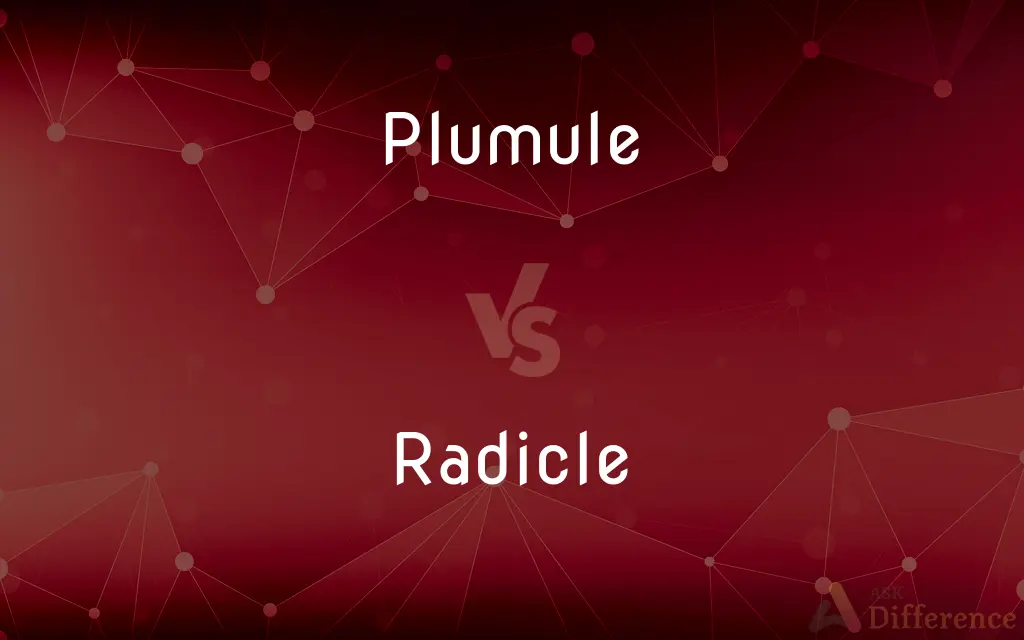Plumule vs. Radicle — What's the Difference?
By Tayyaba Rehman — Updated on October 30, 2023
Plumule refers to the embryonic shoot in a seed that becomes the plant's first leaves, while Radicle is the first root to emerge from a germinating seed.

Difference Between Plumule and Radicle
Table of Contents
ADVERTISEMENT
Key Differences
A Plumule is essentially the embryonic shoot found within a seed. In contrast, the Radicle is the embryonic root. When a seed starts the germination process, the Plumule will eventually give rise to the initial leaves of the plant. The Radicle, however, breaks through the seed coat and begins to grow downward into the soil, establishing the root system.
As the seed continues its growth, the Plumule will start to grow upward, responding to light, and will develop into the plant's shoot system. On the other hand, the Radicle will grow deeper into the soil, anchoring the plant and absorbing water and nutrients.
While both the Plumule and Radicle are essential for the growth of the seed, they serve different functions: the Plumule for the aerial part of the plant and the Radicle for the underground part.
Comparison Chart
Part of Plant
Embryonic shoot.
Embryonic root.
Function
Gives rise to the plant's leaves.
Forms the primary root of the plant.
ADVERTISEMENT
Growth Direction
Grows upwards.
Grows downwards.
Response to
Light (phototropism).
Gravity (gravitropism).
Position in Seed
Typically located above the cotyledons.
Positioned at the tip of the seed embryo.
Compare with Definitions
Plumule
The growth of the Plumule is crucial for the plant's photosynthesis.
The success of the Plumule ensures the plant can produce its food.
Radicle
Radicle's growth is influenced by gravity.
The Radicle shows positive gravitropism, growing downward.
Plumule
Plumule responds to light during growth.
The Plumule grows towards the source of light for photosynthesis.
Radicle
The Radicle is located at the embryo's tip within a seed.
During inspection, the Radicle was identified at the seed's pointed end.
Plumule
Plumule develops into the aerial parts of a plant.
As the seed germinated, the Plumule started to emerge above the soil.
Radicle
A Radicle is the first part of a seedling to emerge during germination.
The Radicle's emergence is the initial sign of seed germination.
Plumule
A down feather.
Radicle
The Radicle provides the plant's initial anchorage and nutrient absorption.
The growth of the Radicle ensures the plant's stability and nourishment.
Plumule
The young shoot of a plant embryo above the cotyledons, consisting of the epicotyl and often of immature leaves.
Radicle
Radicle develops into the primary root system of the plant.
Once the seed began to germinate, the Radicle grew deep into the soil.
Plumule
(botany) The first bud, or growing point, of a plant embryo, situated above the cotyledons.
Radicle
In botany, the radicle is the first part of a seedling (a growing plant embryo) to emerge from the seed during the process of germination. The radicle is the embryonic root of the plant, and grows downward in the soil (the shoot emerges from the plumule).
Plumule
(zoology) A down feather.
Radicle
(Botany) The part of a plant embryo that develops into a root.
Plumule
(zoology) The aftershaft of a feather.
Radicle
(Anatomy) A small structure, such as a fibril of a nerve, that resembles a root.
Plumule
(zoology) One of the featherlike scales of certain male butterflies.
Radicle
(botany) The rudimentary shoot of a plant which supports the cotyledons in the seed, and from which the root is developed downward; the root of the embryo.
Plumule
The first bud, or gemmule, of a young plant; the bud, or growing point, of the embryo, above the cotyledons. See Illust. of Radicle.
Radicle
(botany) A rootlet.
Plumule
A down feather.
Radicle
(chemistry) radical
Plumule
Down feather of young birds; persists in some adult birds
Radicle
The rudimentary stem of a plant which supports the cotyledons in the seed, and from which the root is developed downward; the stem of the embryo; the caulicle.
Plumule
A Plumule is the embryonic shoot in a seed.
The Plumule will grow into the plant's first leaves.
Radicle
(anatomy) a small structure resembling a rootlet (such as a fibril of a nerve)
Plumule
Plumule is found within the seed's embryo.
The germinating seed's Plumule is positioned above the cotyledons.
Common Curiosities
What is a Plumule in a seed?
A Plumule is the embryonic shoot in a seed that develops into the plant's initial leaves.
How does the Radicle typically grow?
The Radicle typically grows downward, influenced by gravity.
Which emerges first during seed germination, the Plumule or the Radicle?
The Radicle usually emerges first during seed germination.
What role does the Plumule play in photosynthesis?
The Plumule develops into the plant's shoot system, which contains leaves essential for photosynthesis.
How does the Radicle contribute to plant growth?
The Radicle is the first root that emerges from a germinating seed, anchoring the plant and starting the root system.
How does the Radicle respond to external stimuli?
The Radicle responds to gravity, exhibiting positive gravitropism.
Which part of a seed grows upwards?
The Plumule grows upwards, responding to light.
Why is the Radicle's growth vital for the seedling?
The Radicle's growth establishes the initial root system, vital for nutrient absorption and anchorage.
Can a seed germinate without a Plumule?
While a seed can technically germinate without a Plumule, it won't develop a proper shoot system, limiting its growth.
How deep can a Radicle grow?
The depth of Radicle growth varies among plants but serves as a foundation for the primary root system.
Is the Plumule found in all seeds?
Most seeds have a Plumule, but its structure and visibility can vary among species.
Does the Radicle absorb nutrients for the seedling?
Yes, the Radicle absorbs essential nutrients and water from the soil for the seedling.
Can a plant survive without a Radicle?
A plant might germinate without a Radicle, but lacking a root system would severely limit its growth and nutrient absorption.
Which is usually longer in a germinating seed, the Plumule or the Radicle?
Initially, the Radicle is often longer as it's the first to emerge and establish the root system.
Is the Plumule always visible in a germinating seed?
Not always. The Plumule becomes more evident as the seed continues its germination process.
Share Your Discovery

Previous Comparison
Dap vs. Run
Next Comparison
Ambifix vs. PrefixAuthor Spotlight
Written by
Tayyaba RehmanTayyaba Rehman is a distinguished writer, currently serving as a primary contributor to askdifference.com. As a researcher in semantics and etymology, Tayyaba's passion for the complexity of languages and their distinctions has found a perfect home on the platform. Tayyaba delves into the intricacies of language, distinguishing between commonly confused words and phrases, thereby providing clarity for readers worldwide.














































